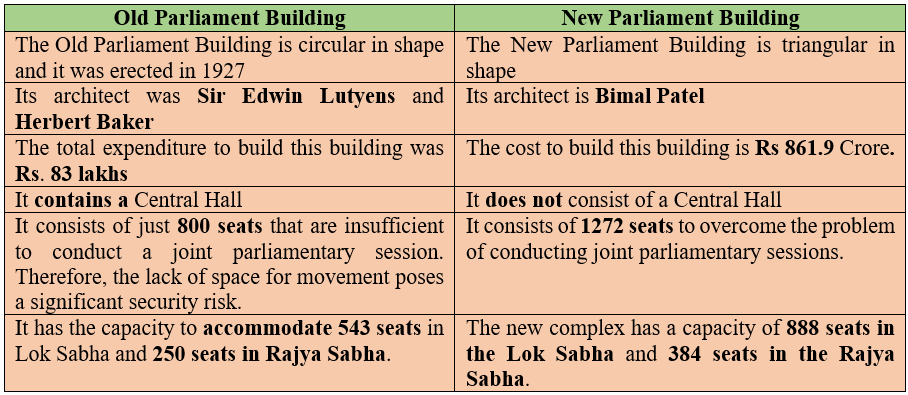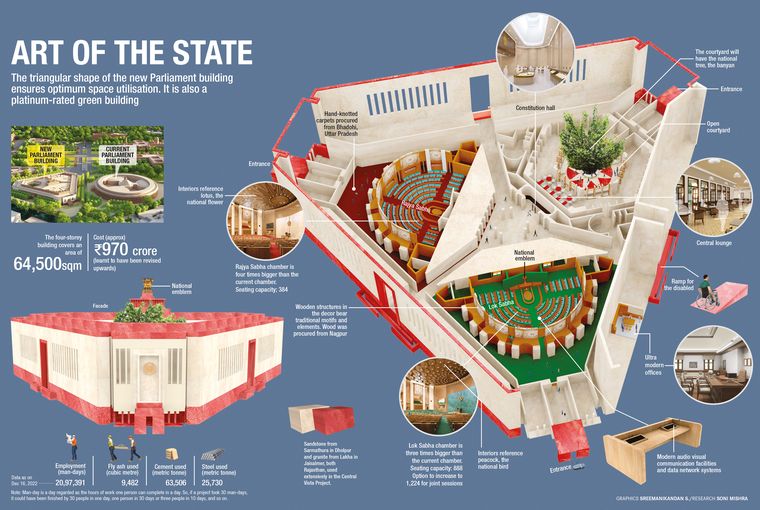PREVIOUS
The New Parliament of India – Part 1
October 4 , 2023
470 days
2636
0
(இதன் தமிழ் வடிவத்திற்கு இங்கே சொடுக்கவும்)
The New Parliament of India

- In the 75th year of Independence, India’s new Parliament building, is embodying the culture, pride and spirit of the entire nation.
- It was recently inaugurated by the PM on Sunday 28th May, 2023.
Key Facts about India’s New Parliament Building
- The new Parliament building is constructed by Tata Projects Ltd.
- The new Parliament, constructed on the lines of the Central Vista buildings, is a triangular structure.
- It houses the Lok Sabha, the Rajya Sabha, the Central Lounge and offices of constitutional authorities.
- The Lok Sabha is based on the theme of the national bird 'peacock'.
- The revamped Rajya Sabha hall is based on the theme of our national flower 'lotus'.

- In the new parliament building, two members will be able to sit side by side on each bench in the Lok Sabha and the Rajya Sabha Chambers.
- Each seat will be equipped with digital systems and touch screens.
- The new building will have a Constitution Hall for the purpose of showcasing India's democratic heritage.
- It will have large committee rooms, with the latest audio-visual systems.
- There will be 92 rooms for the use of the Council of Ministers.
- There will be six committee rooms, the present structure has three.
- The new Parliament complex is also ‘divyang-friendly’.
- With a focus on energy efficiency, the new complex is a “platinum-rated green building”.
- It showcases India’s commitment towards sustainable development.
- It will feature rainwater harvesting and water recycling systems.

Need for a new Parliament building
Existing Parliament is old
- The existing Parliament house (which will be converted into a ‘Museum of Democracy’ after the new Parliament becomes operational) is almost a century-old Heritage Grade-I building, showing signs of distress and over-utilization.
Narrow seating space for MPs
- The present building was never designed to accommodate a bicameral legislature for a full-fledged democracy.
- The Central Hall has seating capacity only for 440 persons and when the Joint Sessions are held, the problem of limited seats amplifies.
- The number of Lok Sabha seats is likely to increase significantly from the current 545 after 2026.
- With the number of Lok Sabha seats fixed at 545 since the 1971 Census-based delimitation, the building's seating arrangements have become cramped and cumbersome.

Distressed infrastructure
- The addition of services like water supply, sewer lines, etc caused huge issues.
- It has led to seepage of water at several places and impacted the aesthetics of the building.
Safety concerns
- For example, fire safety, structural safety (Delhi is currently in Seismic Zone-IV), etc.
Obsolete communication structures
- Communications infrastructure and technology is antiquated in the existing Parliament, and the acoustics of all the halls need improvement.

Inadequate Workspace for Employees
- Over the years, inner service corridors were converted into offices which resulted in poor-quality workspaces.
- In many cases, these workspaces were made even smaller by creating sub-partitions to accommodate more workers.
Outgrowing the Heritage
- The existing Parliament House, commissioned in 1927.
- It is a century-old Heritage Grade-I building.
- With a substantial increase in parliamentary activities and users over the years, the building's age and limited infrastructure no longer meet the current requirements in terms of space, amenities, and technology.
- Heritage Grade-I comprises buildings and precincts of national or historic importance, embodying excellence in architectural style, design, technology and material usage and/or aesthetics.
- It may be associated with a great historic event, personality, movement or institution.
- It has been and is the prime landmarks of the region.
- All natural sites shall fall within Grade-I.

The Significant Features
Optimum Space Utilization
- The new Parliament building, standing alongside the existing one, encompasses a built-up area of approximately 65,000 sq m.
- Its triangular shape ensures efficient utilization of space, accommodating the evolving needs of a growing nation.
Enhanced Seating Capacity
- The new building includes a larger Lok Sabha Hall with a capacity of up to 888 seats and a larger Rajya Sabha hall with up to 384 seats.
- Joint sessions of Parliament can now accommodate up to 1,272 seats.
- It is facilitating inclusive and robust democratic proceedings.
- The new parliament building will not have a central hall.
- The building will have 4 floors with offices of ministers and committee rooms.
- The building is 10% smaller in size than the existing old circular building.

State-of-the-Art Facilities
- A state-of-the-art Constitutional Hall serves as the heart of Indian democracy.
- It is placing citizens at the center of governance.
- The building also offers ultra-modern office spaces equipped with cutting-edge communication technology, promoting efficiency and security.
Commitment to Sustainability
- The new Sansad Bhavan stands as a "Platinum-rated Green Building."
- It is reflecting India's dedication to environmental sustainability.

Cultural Integration
- The new Parliament building seamlessly integrates the vibrance and diversity of modern India, incorporating regional arts, crafts, and cultural elements.
Inclusivity for All
- Recognizing the importance of accessibility, the new Parliament building prioritizes divyang (differently-abled) individuals.
- It ensures that people with disabilities can move freely within the premises, fostering inclusivity and equal participation.

Galleries and Exhibitions
- The public entrances lead to three galleries - the Sangeet Gallery which exhibits dance, song, and musical traditions of India; the Sthapthya Gallery depicts the architectural heritage of the country, and the Shilp Gallery showcases distinct handicraft traditions of different states.
Enhanced Facilities and Access
- The Lok Sabha and the Rajya Sabha chambers boast a digitized voting system, well-engineered acoustics, and state-of-the-art audiovisual systems to ensure effective legislative proceedings.
- The Ministers’ chambers can be accessed through corridors running parallel to the triangular boundary of the building.
- Installation of Sengol, the symbol of power transfer, is symbolic tribute to power transfer to India.

The redevelopment project
- Constructing a triangular Parliament building next to the existing one.
- Constructing Common Central Secretariat.
- Revamping of the 3-km-long Rajpath (Kartavya Path) — from Rashtrapati Bhavan to India Gate.
- North and South Block to be repurposed as museums.
The Historical Significance of Sengol
Chola Period
- The Sengol is derived from the Tamil word "Semmai" which means "Righteousness".
- It was made of gold and was carried by emperors during ceremonial occasions to represent their authority in Chola empire.
- It was handed over from one king to another as a mark of succession and legitimacy.

- The Cholas ruled over parts of Tamil Nadu, Kerala, Karnataka, Andhra Pradesh, Telangana, Odisha, and Sri Lanka from the 9th to 13th century CE.
- The ceremony was usually performed by a high priest or a guru who blessed the new king and conferred him with the Sengol.

Before Independence
- Before Independence there was a question that, ‘What is the ceremony that should be followed to symbolize transfer of power from British?’
- C. Rajagopalachari had suggested Chola ritual of handing over ‘Sengol’ as suitable ceremony for power transfer as it would reflect India’s ancient civilization and culture, as well as its unity in diversity.
- The Sengol was presented to PM Nehru by Thiruvavaduthurai Adheenam (a 500-year-old Saivaite monastery) on August 14, 1947.
- A golden sceptre was crafted by Vummidi Bangaru Chetty, a famous jeweler in Madras (now Chennai).
- The Nandi, with its unyielding gaze as the beholder of “Nyaya”, is hand-carved at the top.

Post Independence
- After receiving the Sengol sceptre in 1947, Nehru kept it at his residence in Delhi for some time before donating it to Anand Bhavan Museum in Allahabad (Prayagraj).
- It remained at Anand Bhavan Museum for over seven decades.
- In 2021-22, when the Central Vista redevelopment project was underway, the government decided to revive this historical event and install the Sengol sceptre in the new Parliament building.
- It has been placed near the Speaker’s seat in the new Parliament building, accompanied by a plaque that will explain its history and meaning.
- The installation of Sengol in the new Parliament building is not just a symbolic gesture but also a meaningful message.
- It signifies that India’s democracy is rooted in its ancient traditions and values and that it is inclusive and respectful of its diversity and plurality.

Leave a Reply
Your Comment is awaiting moderation.


